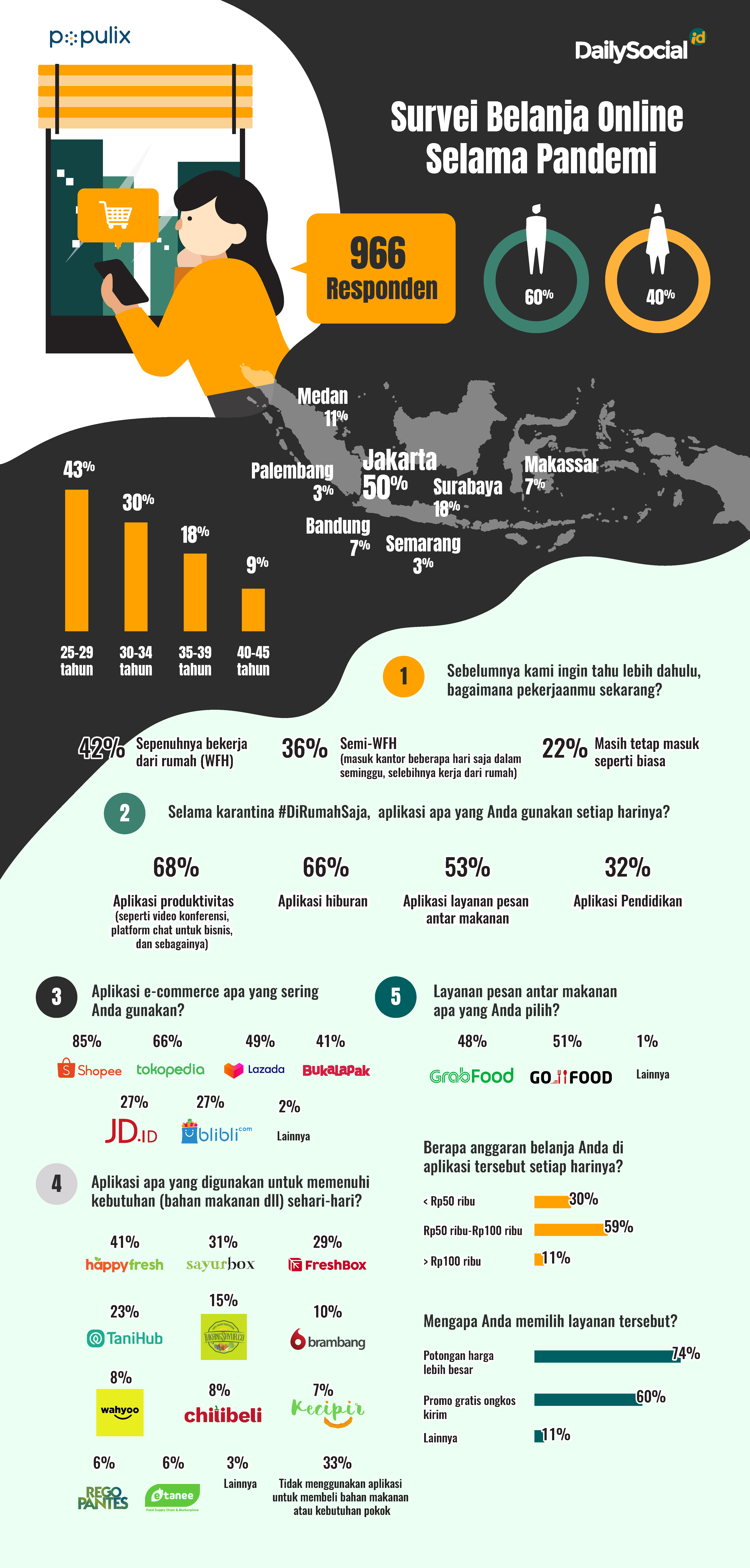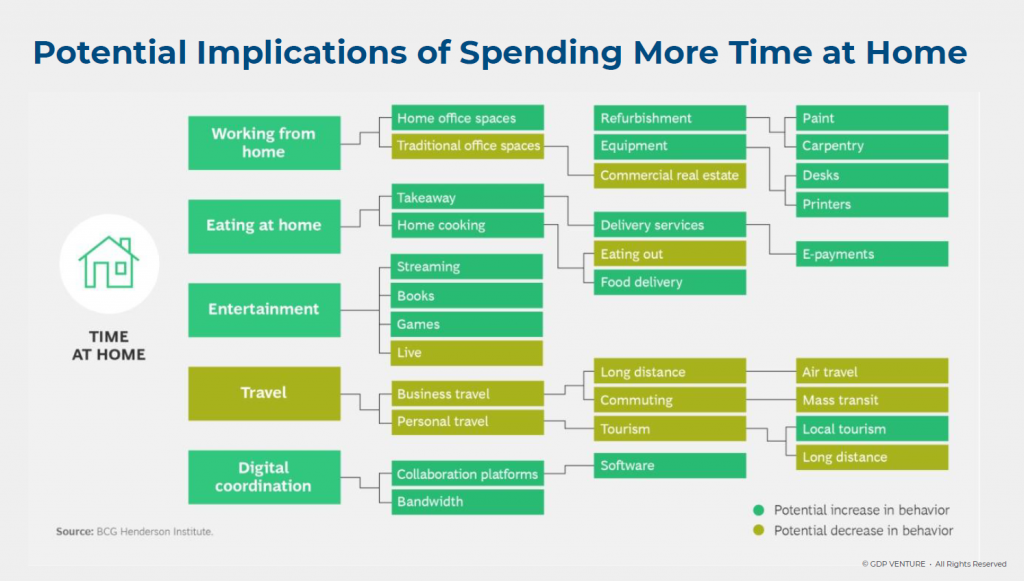A series of the most popular online shopping applications during the pandemic
Offline players shift to online, become merchants on e-commerce or ride-hailing platforms
Continue survey series which are made DailySocial and market research platform Populix, this article discusses online shopping activities during the pandemic. Using the same sample, respondents chose this activity in third place (52%), after productivity applications (68%), and entertainment applications (66%).
Triggered by the implementation of PSBB (Large-Scale Social Restrictions) and quarantine at home, the majority of household needs have turned to online platforms. Whether it's shopping through e-commerce platforms, more specific services (niche), or food delivery services.
The first question we ask is which e-commerce applications are accessed the most?. The top selected apps are Shopee (85%), followed Tokopedia (66%), Lazada (49%), Bukalapak (41%), JD.id (27%), Blibli (27%), and others (2%).
The second question is what applications are used to meet daily needs (food ingredients or so on?). The majority of respondents chose HappyFresh (41%), Vegetable Box (31%), FreshBox (15%), TaniHub (23%), TukangSayur.co (15%), Brambang (10%).
Next, Wahyoo Mart (8%), Chilibeli (8%), Kecipir (7%), RegoPantes (6%), Etanee (6%), others (3%), and lastly not using the app to buy groceries (33%).
The final question is which food delivery service to choose? Respondent answered GrabFood (48%), then GoFood (51%), and others (1%). The budget spent on spending through these services, mostly answered between Rp50 thousand-Rp100 thousand (59%), below IDR 50 thousand (30%), and above IDR 100 thousand (11%).
We asked the reasons why respondents used GrabFood or GoFood. They unanimously stated that the service provided the service provided bigger discount (74%), free shipping promo (60%), and others (11%).
This condition is in line with the results of a survey conducted by Nielsen, as summarized by GDP Venture entitled "The Impact of the Covid-19 Pandemic". It is stated that 30% of respondents plan to shop through online platforms more often.
Although the contribution from online channels is relatively small for FMCG, the intention to shop online can be led by FMCG products because consumers plan to reduce visits to wholesale stores or modern stores.
Supporting the above findings, Brandwatch, and compiled from other sources, e-commerce applications recorded an increase in shopping activity of up to 30% for purchases of health and medical products, groceries, and food delivery.
From the results of another survey collected by JakPat, it is stated that the majority of respondents in various locations choose to prepare their meals at home, either for themselves (67%) or for their families (44%).
Meanwhile, respondents who eat food from outside the home, either through the application or via email take-out, mostly done by respondents who live outside Jakarta. This is triggered by the PSBB policy in the Jabodetabek area which is the center point of the spread of Covid-19.
Another finding states that respondents who work in Java (including Jakarta) tend to use food delivery applications. Meanwhile, those outside Java tend to choose to prepare their own meal. In addition, housewives in Java (outside Jakarta) have the largest percentage of orders through online applications.
Big market
Food delivery service nothing new, but thanks to apps and smartphones there is an expansion of the delivery range. Globally, its market share is worth more than $35 billion per year and is expected to reach $365 billion by 2030.
One of the benefits of online delivery is that consumers are spoiled for choice as they can order a variety of menus through a single app. As a result, they are able to try new foods every day, including adjusting menu options for health-conscious customers.
Google and Temasek's report "e-Conomy SEA 2019" states that the market share of this sector will continue to stretch to $8 billion in 2025 from $2 billion in 2018. Gojek and Grab Those participating in this sector are using their advantage thanks to their well-known brands and large user base to compete with food delivery “pure players”, such as Deliveroo and Foodpanda.
The impact of the pandemic has forced many affected businesses to quickly adapt or have to go out of business, including restaurant businesses of various business scales. One of the fastest options is to shift to the online route, to become a seller on an e-commerce platform because consumers already have traction and are widely used, or to become a merchant on GoFood and GrabFood.
Tokopedia noted an exponential increase in transactions, both from purchases and the number of sellers who joined. There is no detailed mention of the increase. However, it is given an illustration that last year there were around 5 million sellers on Tokopedia, while now it has reached 7,8 million.
Tokopedia's AVP of Product Priscilla Anais said this increase was triggered by many businesses being forced to close their physical stores and limit their operations due to the pandemic. Finally they slowly shifted their business to online from offline.
"So the growth is exponential. We experienced a drastic increase in new sellers during the Covid-19 period. Most are offline sellers migrating to online,” he said.
Of the product categories that were purchased the most, it was explained that the ones that experienced an increase were personal care and health, entertainment products, and products to support work and study from home.
Shopee findings, the highest choice of survey respondents DailySocial with Populix, more or less similar to Tokopedia. In an official statement, the company stated that the increase in demand occurred for the categories of home supplies, food and beverages, to the needs of mothers & babies during the pandemic.
During the month of Ramadan, Shopee observed an upward trend for the seasonal fashion category and mobile phones & accessories were the most popular. In addition, there is an increase in demand for the home decoration category and home & living.
Interestingly, both Tokopedia and Shopee have developed their curation of popular categories to be more segmented according to type and the closest location to buyers. Food categories, shopping for staples, to frozen food now have their own category. This service, compared to its own food delivery business vertical Gojek and Grab, one might say compete.
The drastic shift in people's consumption patterns has forced business people to adapt quickly, even though this is not an easy thing. According to the BCG Henderson Institute, the implications of quarantine at home are that for some businesses, some are suffering, some are reaping profits. Online shopping activities go to the last section.
- Disclosure: This article is supported by a market research platform Populix.
Sign up for our
newsletter


